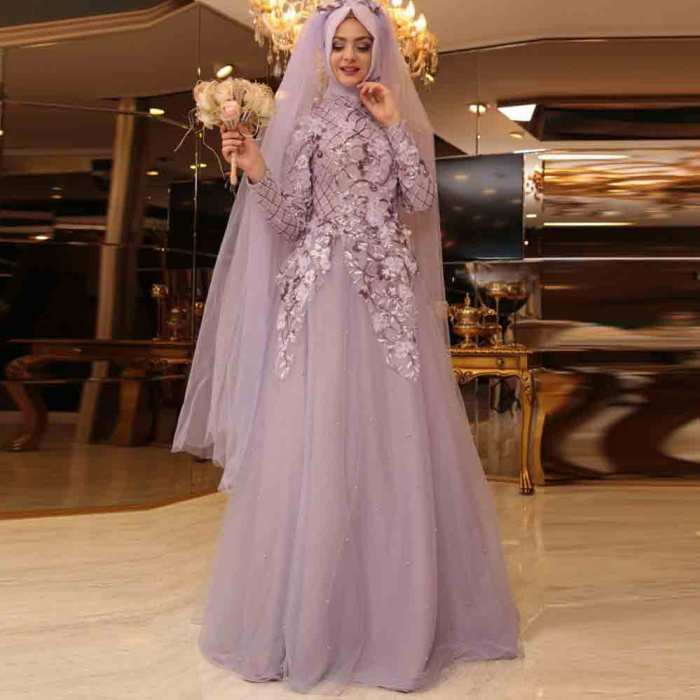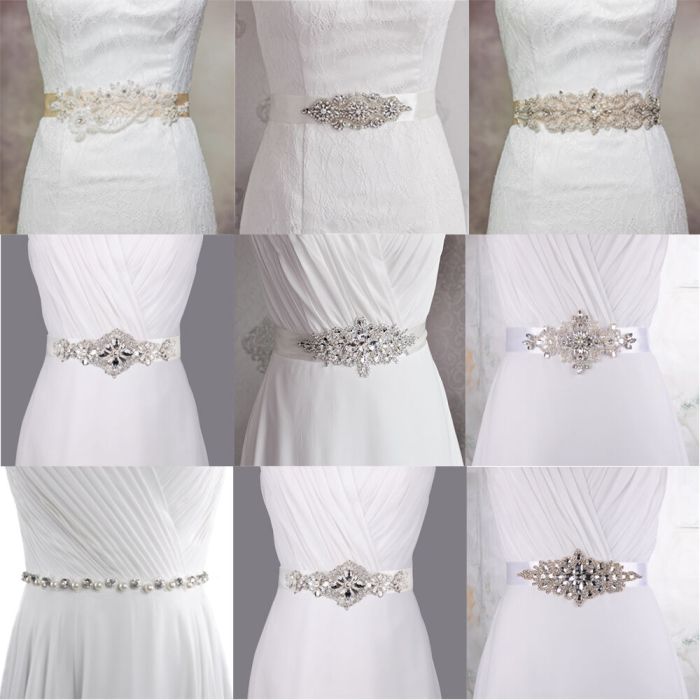Styles and Trends in Muslimah Wedding Dresses
Wedding dress for muslimah – The world of Muslimah wedding attire has undergone a significant evolution over the past decade, reflecting both changing fashion trends and a growing desire for elegant, modest designs. This evolution blends traditional craftsmanship with contemporary styles, creating a diverse and stunning range of options for modern brides.
Evolution of Muslimah Wedding Dress Styles

Source: fashioneven.com
Over the past decade, Muslimah wedding dresses have moved away from solely traditional styles, embracing modern silhouettes and incorporating international fashion influences. Initially, designs were often simpler, focusing on loose-fitting gowns and modest coverings. Now, we see a wider variety of cuts, including A-line, mermaid, and empire waist styles, all adapted to maintain modesty. The use of embellishments has also become more sophisticated, with intricate embroidery, beading, and delicate lace work gaining popularity.
Modern Trends in Muslimah Wedding Attire
Three prominent trends currently shaping Muslimah wedding fashion are the incorporation of luxurious fabrics, the use of unique silhouettes, and the emphasis on personalized details. These trends allow brides to express their individual style while adhering to their religious beliefs.
- Luxurious Fabrics: High-quality fabrics like silk, chiffon, and organza are increasingly popular, adding a touch of opulence to the designs.
- Unique Silhouettes: Designers are experimenting with modern silhouettes, such as sleek sheath dresses or dramatic ball gowns, while ensuring they remain modest.
- Personalized Details: Brides are increasingly opting for personalized touches, such as bespoke embroidery, unique color palettes, and custom-designed veils, to reflect their individual personalities.
Comparison of Traditional and Contemporary Muslimah Wedding Dress Designs
Traditional and contemporary Muslimah wedding dresses share a common thread of modesty, but differ significantly in their aesthetic and construction. Traditional designs often prioritize simplicity and functionality, while contemporary designs embrace modern trends and individual expression.
| Style | Description | Materials | Region of Origin |
|---|---|---|---|
| Traditional Jubah | Loose-fitting, often floor-length robe with long sleeves. | Silk, cotton, brocade | Various Muslim-majority countries |
| Modern A-line Gown | Fitted bodice, flowing skirt, often with long sleeves or three-quarter sleeves. | Silk, chiffon, lace | International |
| Contemporary Mermaid Gown | Fitted bodice and skirt that flares out at the knees. | Lace, satin, tulle | International |
| Traditional Kaftan | Loose-fitting, often embellished with embroidery or beading. | Silk, velvet, brocade | Middle East, North Africa |
Color and Embellishments in Muslimah Wedding Dresses
Color and embellishments play a vital role in enhancing the beauty and elegance of Muslimah wedding dresses. While ivory and white remain classic choices, a wider range of colors, including pastels and jewel tones, are becoming increasingly popular. Embellishments such as embroidery, beading, sequins, and delicate lace add intricate details and a touch of luxury.
Fabrics and Materials
The choice of fabric significantly impacts the overall look, feel, and comfort of a Muslimah wedding dress. Understanding fabric properties, ethical sourcing, and price points is crucial for making an informed decision.
Common Fabrics and Their Properties
Several fabrics are commonly used in Muslimah wedding dresses, each with unique properties that make them suitable for different climates and styles. The choice often depends on the bride’s preferences and the overall aesthetic of the dress.
- Silk: Luxurious, breathable, and drapes beautifully. However, it can be expensive and requires delicate care.
- Chiffon: Lightweight, sheer, and flows gracefully. Ideal for warmer climates.
- Organza: Crisp, stiff, and creates volume. Often used for overlays or embellishments.
- Lace: Delicate, intricate, and adds a touch of elegance. Can be combined with other fabrics for added support and structure.
- Cotton: Breathable and comfortable, especially suitable for warmer climates. Often used for linings or undergarments.
Ethical Sourcing and Sustainability
Increasingly, brides are prioritizing ethical and sustainable fabric choices. This involves considering the environmental impact of production, fair labor practices, and the use of eco-friendly materials. Looking for certifications like GOTS (Global Organic Textile Standard) or OEKO-TEX can help ensure ethical and sustainable sourcing.
Luxurious and Affordable Fabric Options
The choice of fabric can significantly influence the cost of a Muslimah wedding dress. Luxurious options like silk and high-quality lace command higher prices, while more affordable alternatives such as cotton blends or polyester blends offer budget-friendly choices without compromising on style.
Fabric Suitability and Price Range
| Fabric | Climate Suitability | Price Range |
|---|---|---|
| Silk | Moderate to cool climates | High |
| Chiffon | Warm to moderate climates | Medium |
| Organza | Moderate climates | Medium |
| Lace | Moderate climates | Medium to High |
| Cotton | Warm climates | Low to Medium |
Modesty and Design Elements: Wedding Dress For Muslimah
Modesty is a paramount consideration in Muslimah wedding dress design. Designers achieve this through careful selection of fabrics, silhouettes, and embellishments, ensuring the dress remains both elegant and respectful of religious norms.
Incorporating Modesty While Maintaining Elegance
Designers achieve modesty through several techniques, including using long sleeves, floor-length skirts, high necklines, and avoiding revealing cuts or fabrics. These elements are skillfully integrated to create elegant and sophisticated designs that reflect both tradition and contemporary style.
Key Design Elements for Modesty
Five key design elements contribute significantly to the modesty of a Muslimah wedding dress:
- Long Sleeves: Covering the arms is a fundamental aspect of modest attire.
- Floor-Length Skirt: Ensures the legs remain covered.
- High Neckline or Covered Neckline: Protects the chest and shoulders.
- Loose-Fitting Silhouette: Avoids revealing the body shape.
- Opaque Fabrics: Prevents transparency and ensures full coverage.
Incorporating Hijab Styles with Different Necklines, Wedding dress for muslimah
The hijab can be elegantly incorporated with various wedding dress necklines. For instance, a flowing hijab can complement a high neckline, while a more structured hijab can be paired with a boat neck or V-neck.
Common Modest Design Features and Cultural Significance
Many modest design features hold cultural significance, reflecting the traditions and values of various Muslim communities. For example, intricate embroidery might represent family heritage, while specific colors or fabrics may be associated with auspicious occasions.
- Embroidery: Often reflects cultural heritage and family traditions.
- Specific Colors: May hold symbolic meaning in different cultures.
- Traditional Fabrics: Represent cultural identity and heritage.
Accessories and Styling
Accessories play a crucial role in completing a Muslimah bride’s wedding ensemble. Careful selection of veils, jewelry, and footwear enhances the overall look and feel of the attire, adding a touch of personal style and elegance.
Appropriate and Stylish Accessories
Appropriate accessories for a Muslimah bride include a modest veil, delicate jewelry (avoiding excessive displays), and comfortable yet elegant footwear. The choice of accessories should complement the dress and reflect the bride’s personal style.
Hijab Styling Techniques for a Wedding
Various hijab styling techniques can be used to complement different wedding dress necklines and overall aesthetics.
- Classic Drape: A simple and elegant style suitable for most necklines.
- Turban Style: A sophisticated and modern option.
- Layered Style: Adds volume and texture, ideal for more elaborate dresses.
- Side-Swept Style: A chic and contemporary look.
- Flower Embellishments: Adds a touch of femininity and elegance.
Impact of Accessories on Overall Look
Accessories significantly impact the overall aesthetic of the wedding attire. They can add a touch of glamour, enhance the color palette, and reflect the bride’s personality. Careful selection ensures a cohesive and harmonious look.
Visual Description of a Muslimah Bride’s Wedding Ensemble
Imagine a bride in a flowing ivory silk A-line gown, adorned with delicate lace appliqués. She wears a flowing chiffon hijab in a soft blush pink, elegantly draped over her shoulders. Delicate diamond earrings and a simple pearl necklace complement her look. Her makeup is natural and radiant, enhancing her features. Her hair is styled in a soft updo, partially veiled under the hijab.
She wears comfortable yet elegant ivory heels, completing her sophisticated and modest bridal ensemble.
Cultural Variations
Muslimah wedding dress styles vary significantly across different cultures, reflecting unique traditions, fabrics, and design preferences. These variations showcase the rich diversity within the Muslim world.
Comparison of Muslimah Wedding Dress Styles Across Cultures
Indonesian, Moroccan, and Pakistani Muslimah wedding dresses, for example, demonstrate distinct regional influences in their design, fabrics, and embellishments. These differences highlight the rich tapestry of cultural traditions within the Muslim world.
Cultural Significance of Design Elements and Fabrics
Specific design elements and fabrics hold significant cultural meaning in different regions. For instance, certain embroidery patterns might represent family heritage, while specific colors or fabrics may be associated with auspicious occasions or religious beliefs.
Influence of Regional Traditions on Aesthetics
Regional traditions profoundly influence the overall aesthetic of Muslimah wedding dresses. These traditions shape the choice of fabrics, embellishments, silhouettes, and overall design philosophy, resulting in a unique and diverse range of styles.
| Region | Typical Style | Key Features | Common Fabrics |
|---|---|---|---|
| Indonesia | Elaborate kebaya with long skirt | Intricate embroidery, pastel colors | Silk, batik |
| Morocco | Caftan with ornate embellishments | Rich colors, metallic threads, detailed embroidery | Silk, velvet, brocade |
| Pakistan | Sharara or gharara with long shirt | Intricate embroidery, vibrant colors | Silk, chiffon, net |
Finding and Choosing a Muslimah Wedding Dress
Choosing a Muslimah wedding dress is a significant decision, requiring careful consideration of personal style, religious beliefs, and practical factors. Finding a reputable designer or retailer specializing in modest attire is crucial for a positive experience.
Finding a Reputable Designer or Retailer
Finding a reputable designer or retailer specializing in Muslimah wedding attire can be done through online research, referrals from other brides, or attending bridal shows. It is essential to check reviews and ensure the designer or retailer aligns with the bride’s vision and values.
Selecting a Dress Reflecting Personal Style and Religious Beliefs
The selection process should involve trying on various styles to determine what best flatters the bride’s body type and reflects her personal style. It’s crucial to ensure the chosen dress adheres to the bride’s religious beliefs and provides comfortable and appropriate coverage.
Importance of Trying On Different Styles and Considering Body Type
Trying on different styles is essential to understand how different silhouettes and designs flatter the bride’s body type. This process allows for informed decision-making, ensuring the chosen dress is both beautiful and comfortable.
Finding the perfect wedding dress for a Muslimah often involves balancing tradition and modern style. Many designers now cater to this, offering modest yet elegant options. For brides seeking luxurious fabrics and exquisite detail, exploring the designs of rosa clara wedding dress could be a worthwhile pursuit, as their craftsmanship often allows for adaptations to suit various modesty requirements.
Ultimately, the ideal wedding dress for a Muslimah is one that reflects her personal style and faith beautifully.
FAQs
What is the average price range for a Muslimah wedding dress?
The price varies greatly depending on the designer, fabric, embellishments, and level of customization. Prices can range from a few hundred dollars to several thousand.
Can I alter a ready-to-wear dress to make it more modest?
Yes, many alterations are possible. A seamstress can add sleeves, adjust necklines, or lengthen the hemline to achieve a more modest look.
Where can I find Muslimah-friendly wedding dress designers?
Online searches, bridal boutiques specializing in modest wear, and recommendations from other Muslimah brides are excellent starting points.
How far in advance should I start looking for my wedding dress?
It’s generally recommended to begin your search at least 6-12 months before your wedding date to allow ample time for alterations and customizations.

